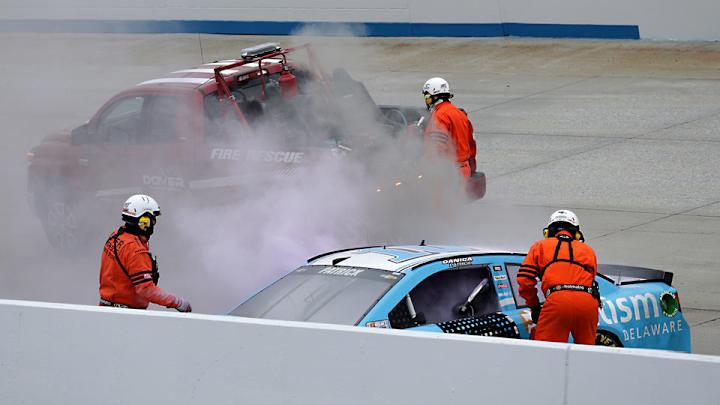Tony Stewart in 3-car wreck at start of NASCAR practice

DOVER, Del. (AP) Tony Stewart could not avoid the oil spill on the concrete track that spun his Chevrolet and slammed the car into an unprotected wall on the front stretch.
''That hurt,'' he told his team over the radio.
Spins happen, it's part of racing.
But the fact his car struck an exposed wall just days after Dover International Speedway touted its addition of energy-absorbing soft walls - SAFER barriers - made NASCAR drivers ask why each part of the unforgiving walls were not covered.
''There's really no excuse not to have it,'' pole winner Kevin Harvick said. ''We don't wear our helmets and HANS devices for the impacts that we are prepared for. We wear those things for the instances where those one-off things can happen like what happened today.''
Just 4 minutes into Friday's lone practice, Danica Patrick's No. 10 dumped oil on the track, spun and the rear of her Chevrolet burst into flames. Stewart was behind her and the No. 14 followed the skids marks into the oil and smacked the wall. Jamie McMurray also was collected in the wreck, his No. 1 Chevy also a victim of the uncovered portion of the wall. McMurray held his left elbow as he left the track medical center.
Stewart, who did not talk to the media, suffered his first serious hit since his return from a back injury for what will be his final season in Sprint Cup. Stewart missed the first eight races of the season with a fractured vertebra suffered in a January all-terrain vehicle accident. He and Stewart-Haas Racing teammate Patrick returned to the track later in backup cars, as did McMurray.
''You worry for Tony, just making sure he is OK after everything he has gone through physically,'' Patrick said.
Stewart-Haas Racing said Stewart was fine. Greg Zipadelli, SHR vice president of competition, said Patrick's car suffered from gear issues. McMurray made light of his injury on Twitter.
''Elbow will be sore for a while....nothing `Funny' about it,'' he tweeted.
The drivers aren't laughing, especially with safety again at the forefront because of recent concerns over the likelihood of cars racing with unsecured lug nuts. By using less than five on each tire, a team would have a faster pit stop and potentially gain track position. Stewart complained the practice was dangerous, and NASCAR fined him $35,000 for his criticism. NASCAR then said it would check all cars for five lug nuts before and after each race. Sure enough, Kyle Busch's crew chief and tire changer for one race for violating the lug nut policy during the team's win at Kansas last weekend.
Dover just completed the installation of 479 feet of SAFER barriers along the backstretch and into the entrance of Turn 3. That includes 78 feet of standard SAFER barriers to the existing inside backstretch wall and 401 feet in front of a new, steel post inside wall.
Patrick two weeks ago suffered perhaps the most frightening crash of her career when her car caught fire and ran smack into an energy-absorbing wall at Talladega with eight laps to go. She was bruised and it hurt to breathe.
''All the experiences I've had hitting the wall, the ones where you hit the wall I think I saw it's about twice the G-load impact when you hit a non-safer barrier,'' Patrick said Friday. ''It shouldn't even be a question whether or not tracks have SAFER barrier all the way around. It should be mandatory. It shouldn't be a financial decision.''
Tracks consult with NASCAR and University of Nebraska safety experts for soft wall placement recommendations. Dover President Mike Tatoian told The Associated Press the track spent about $400,000 on the new SAFER barriers. Tatoian would not rule out adding more.
''This is a new data point and it will be reviewed. We will react accordingly,'' he said. ''It's not a financial decision. It's what is prudent, what's the right decision.''
Six-time Cup champion Jimmie Johnson, a 10-time winner at Dover, said he ''just assumed'' every wall at Dover had a SAFER barrier. Because the barriers extended the wall closer to the track surface, drivers would have to find a new groove if the walls altered the racing conditions.
Dale Earnhardt Jr. said drivers were fine once walls were installed at other tight tracks such as Bristol and Martinsville. The three drivers in Friday's fiery wreck were pushing about 160 mph at the time of the accident.
''At this place you hit one wall and you slide down and you hit another,'' Earnhardt said. ''You're going to get a couple licks there in some of those instances that aren't going to be a lot of fun.''
It's the kind of punishing blow that drivers would love to soften.
''Man, I would take a soft wall over a hard wall any day in any situation,'' Johnson said.
